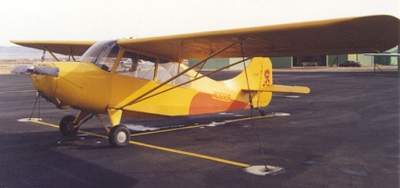Wiring Issue Could Lead To Fires
The FAA has issued a Special Airworthiness Information Bulletin (SAIB) for Aeronca, Bellanca, Champion, or American Champion Aircraft Corporation (ACAC) regarding possible electrical system shorts that could lead to fires. ACAC is the current type certificate holder for all of the airplane models affected by this SAIB.

This SAIB resulted from an accident in the country of Hungary, where a Model 8GCBC airplane caught fire upon start-up of the engine and burned. The Transportation Safety Bureau of Hungary found the fire probably started at the passage of the high power cable through the firewall due to signs of electric discharge at the passage and melting of the electric cable in the line of the firewall. It was determined that ACAC Service Letter number 418, dated January 19, 2001, titled Electrical System Update, had not been incorporated on the Hungarian 8GCBC.
Until 2001, various 7 and 8 series airplane models were manufactured by Aeronca, Bellanca, Champion, and ACAC without electrical system short protection. Particularly prone to shorting are airplanes with the main battery mounted in the rear of the airplane that have the battery cable routed to the engine compartment with no fuses/circuit breakers/ (to automatically remove power) or relays (for the pilot to remove power) in the event of an electrical short. Most known electrical shorts have occurred where electrical power passes through the airplane firewall (either battery power going from the rear of the airplane to the engine compartment or alternator power going from the engine compartment to the airplane DC bus). There have also been occurrences of flight control cables burning through from electrical shorts to the rear-mounted positive battery cable. In these cases current flows into the flight control cable from the battery cable (+) contact point and exits the cable at a pulley or terminal
(-).
In addition, the fact that there is no circuit protection in the electrical power to the voltage regulator/overvoltage relay is a problem when a short occurs in the regulator or the relay. In one service difficulty, a short in the overvoltage relay caused the power wire to the relay to melt. The heat also melted the ignition P-leads, causing them to short, which resulted in an in-flight engine stoppage. ACAC issued Service Letter number 418, on January 19, 2001 to address the safety concerns, as described above, regarding the electrical systems on airplane models affected by this SAIB. The FAA conducted two risk analyses following the Small Airplane Risk Assessment (SARA) Handbook; one looking at the trend over 40 years and one looking at the last 20 years. The FAA found that the risk has been reduced since ACAC Service Letter number 418 was issued on January 19, 2001. Both our analyses showed the risk below a level requiring an AD. Although the risk does not rise to the level or warranting mandatory
action, the FAA has decided to issue an SAIB to elevate the level of attention by owners/operators as well as by the civil aviation authorities of other countries where American Champion airplanes are owned and operated.
The affected models include:
- 7AC, S7AC, 7BCM, 7CCM, S7CCM, S7DC, 7DC, 7EC, & S7EC; with electrical systems; (Type Certificate A-759)
- All 7FC, 7GC, 7HC, 7GCA, 7JC, 7GCB, 7KC, 7GCBA, 7KCAB, 7ACA. (Type Certificate A-759)
- 7ECA, serial numbers 1 through 1381-2000. (Type Certificate A-759)
- 7GCAA, serial numbers 1 through 438-2000. Type Certificate A-759)
- 7GCBC, serial numbers 1 through 1288-2000. (Type Certificate A-759)
- 8KCAB, serial numbers 1-70 through 859-2000. (Type Certificate A21CE)
- 8GCBC, serial numbers 1-74 through 412-2000.(Type Certificate A21CE)
The FAA recommends that all that ACAC model airplanes identified in the introduction above complete the installation of American Champion Service Letter number 418, dated January 19, 2001. The agency also recommends that the aircraft maintenance manual (AMM) be updated with pages from the American Champion service letter to address the addition of circuit protection devices. This will ensure the locations, mounting, and sizes of new fuses, circuit breakers, relays, and bulkhead feedthroughs, are available to maintenance personnel. Finally, it is recommend the Airframe and Powerplant technician performing the minor alteration document the work with an aircraft logbook entry.
(Image from file)
 Airborne 04.16.24: RV Update, Affordable Flying Expo, Diamond Lil
Airborne 04.16.24: RV Update, Affordable Flying Expo, Diamond Lil ANN's Daily Aero-Term (04.20.24): Light Gun
ANN's Daily Aero-Term (04.20.24): Light Gun Aero-News: Quote of the Day (04.20.24)
Aero-News: Quote of the Day (04.20.24) Aero-News: Quote of the Day (04.21.24)
Aero-News: Quote of the Day (04.21.24) ANN's Daily Aero-Term (04.21.24): Aircraft Conflict
ANN's Daily Aero-Term (04.21.24): Aircraft Conflict



